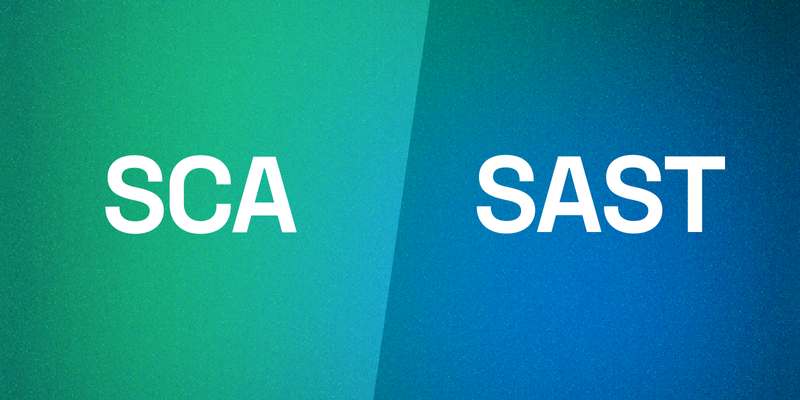SCA (Software Composition Analysis) and SAST (Static Application Security Testing) tools both play important roles in secure application development, but there are notable differences between them.
The biggest is that SCA tools focus on open source dependencies and their associated risks, while SAST tools focus on your proprietary code — e.g., the custom code your developers write or maintain, including how an open source component is used in proprietary code.
As such, SAST provides a different perspective on vulnerabilities or weaknesses than SCA. Where SAST would tell you, “Your code has improper input validation,” SCA would tell you, “The code (OSS) your code is using has improper input validation.” In other words: The tools surface similar vulnerabilities, yet on dramatically different attack surfaces.
Another significant difference is SCA has multiple use cases beyond vulnerability management, including SBOM management and open source license compliance.
For these reasons, SCA and SAST are considered complementary: SAST tests your code and coding practices, while SCA tests your third-party code.
In this blog, we’ll explain how both SCA and SAST work, the important differences between them, and how the tools can work together to strengthen security.

SCA, Explained
SCA tools analyze, inventory, and manage open source dependencies, their licenses, and their vulnerabilities. SCA works by scanning software applications to identify the third-party components and libraries they depend on. SCA tools can integrate with various development and CI/CD tools to automate the analysis as part of the software development process.
SCA supports several distinct use cases:
Open source license compliance: SCA tools report a list of open source licenses (and their associated dependencies) when scanning code. Some SCA tools (like FOSSA) will also list the obligations that your licenses carry — and even offer functionality to help achieve compliance, such as automating license notice creation. Additionally, SCA tools with strong policy engines can be configured to block builds if an out-of-policy license is detected.
SBOM generation: Creating a software component inventory is a fundamental SCA capability, so it shouldn’t be a surprise that many SCA tools also support SBOM generation. For example, organizations can use FOSSA’s SCA offering to generate SBOMs in both the SPDX and CycloneDX formats, with a range of customization options. Some SCA tools also support third-party SBOM ingestion and management.
Open source vulnerability management: Beyond providing an inventory of known vulnerabilities (CVEs), SCA can help with prioritization and remediation. For example, FOSSA will show the CVSS and EPSS scores for a given vulnerability to support prioritization, and we’ll also report the fix and code path to help with remediation.
SAST, Explained
SAST is used to analyze an application’s source code, bytecode, or binary code for security vulnerabilities — without executing the program. SAST tends to be used very early in the software development lifecycle (such as in the development phase), which helps developers and security teams address possible security issues before deploying an application.
SAST identifies potential vulnerabilities by using predefined rulesets or security patterns. These rulesets are created based on known security best practices and common coding mistakes that may lead to security issues, including SQL injection, cross-site scripting (XSS), buffer overflows, and other security vulnerabilities. In practice, these vulnerabilities result in threat actors escalating authorized privileges, accessing restricted data, or executing malicious code.
SAST utilizes several techniques to identify vulnerabilities, such as:
- Data flow analysis: This tracks how data moves through the application. It includes control flow analysis (to understand the order in which different parts of the code are executed) and code path analysis (understanding conditional statements, loops, and different execution paths).
- Taint analysis: This tracks the flow of untrusted or tainted data through the application. If user input is not properly sanitized or validated, it can be considered tainted, and the tool traces its path through the code to identify potential security risks.
Key Differences Between SCA and SAST
As we’ve discussed, although SCA and SAST both support security use cases, there are significant differences between the two tools. Here are some of the biggest.
- SCA is used to identify open source dependencies. SAST is used to analyze proprietary or first-party code.
- SAST tools do require access to source code, while SCA tools may not.
- SCA supports open source license compliance and SBOM use cases, while SAST does not.
- When SCA surfaces a vulnerability, the remediation is often upgrading (or replacing) an open source component. With SAST, the remediation is generally to modify the actual application code.
- SAST tends to be used earlier in the SDLC than SCA, in the development phase rather than the build phase.
Despite these differences, it is worth noting that a majority of vulnerabilities reported by SCA tools are the direct result of "SAST" scans on the source of an open source dependency. So, essentially, most open source vulnerabilities are SAST results run against that proprietary or open source code that have been published in a public database (such as MITRE, NIST, GitHub advisory, and so forth).
SCA and SAST: The Bottom Line
Although SAST and SCA work differently and have different purposes, they’re both important parts of managing security risks for modern applications. As such, many organizations benefit from using both tools. This is often done via integration into your CI/CD pipeline, which ensures that security assessments are conducted automatically with every code commit and deployment, providing timely feedback to developers.
With SCA and SAST in place — along with other testing tools and the right people and processes — organizations can strengthen their defenses against a range of security and open source license compliance risks.
For more information on FOSSA’s SCA tool and how it works, we recommend visiting our SCA product page.


